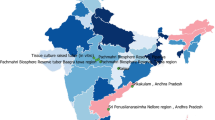Abstract
Plantago ovata, commonly called as the 'desert Indian wheat' is a cultivated and economically important plant of the genus Plantago, a large genus containing ~200 species. It yields Psyllium (Isabgol) which has several health benefits and applications in pharmaceutical, food and cosmetic industries. In view of the genetic uniformity, detection of variability has remained a challenge in this species as the plant lacks inherent variability and has a narrow genetic base. During the present study, Random amplified polymorphic DNA (RAPD) was used to determine genetic relationship and detect whatever little hidden variation exists in this species and some of its wild allies. Limited genetic variability was observed in P. ovata whereas; extensive genetic variability was seen in its wild allies. The genetic distances among different accessions of P. ovata and different species of Plantago, were used to generate a dendrogram.
Similar content being viewed by others
References
Rahn, K., A phylogenetic study of the plantaginaceae, Bot. J. Linn. Soc., 1996, vol. 12, pp. 145–198.
Dhar, M.K., Kaul, S., Sareen, S., and Koul, A.K., Plantago ovata: Cultivation, genetic diversity, chemistry and utilization, Plant Genet. Resour., Cult. Util., 2005, vol. 3, pp. 252–263.
Dhar, M.K., Kaul, S., Sharma, P., and Gupta, M., Plantago ovata: Cultivation, genomics, chemistry and therapeutic applications, in Genetic Resources, Chromosome Engineering and Crop Improvement, Singh, R.J., Ed., New York: CRC Press, 2011, pp. 764–794.
Dhar, M.K., Fuchs, J., and Houben, A., Distribution of euand heterochromatin in Plantago ovate, Cytogenet. Genome Res., 2009, vol. 125, pp. 235–240.
Kotwal, S., Dhar, M.K., Kour, B., Raj, K., and Kaul, S., Molecular markers unravel intraspecific and interspecific genetic variability in Plantago ovata and some of its wild allies, J. Genet., 2013, vol. 92, pp. 293–298.
Samantaray, S., Dhagat, U.M., and Maiti, S., Evaluation of genetic relationships in Plantago species using Random Amplified Polymorphic DNA (RAPD) markers, Plant Biotechnol., 2010, vol. 27, pp. 297–303.
Ragot, M. and Hoisington, D.A., Molecular markers for plant breeding: Comparisons of RFLP and RAPD genotyping costs, Theor. Appl. Genet., 1993, vol. 86, pp. 975–984.
Heun, M., Murphy, J.P., and Phillips, T.D., A comparison RAPD and isozyme analyses for determining the genetic relationship among Avena sterilis L. accessions, Theor. Appl. Genet., 1994, vol. 87, pp. 689–696.
Hilu, K.W., Evidence from RAPD markers in the evolution of Echinochloa millets (Poaceae), Plant. Syst. Evol., 1994, vol. 189, pp. 247–257.
Yu, L.X. and Nguyen, H.T., Genetic variation detected with RAPD markers among upland and lowland rice cultivars (Oryza sativa L.), Theor. Appl. Genet., 1994, vol. 87, pp. 668–672.
Halward, T., Stalker, T., LaRue, E., and Kochert, G., Use of single-primer DNA amplification in genetic studies of peanut (Arachis hypogeae L.), Plant Mol. Biol., 1992, vol. 18, pp. 315–325.
Santos, dos J.B., Nienhuis, J., Skroch, P., Tivang, J., and Slocum, M.K., Comparison of RAPD and RFLP genetic markers in determining genetic similarity among Brassica oleracea L. genotypes, Theor. Appl. Genet., 1994, vol. 87, pp. 909–915.
Yang, X. and Quiros, C., Identification and classification of celery cultivars with RAPD markers, Theor. Appl. Genet., 1993, vol. 86, pp. 205–212.
Orozco-Castillo, C., Chalmers, K.J., Waugh, R., and Powell, W., Detection of genetic diversity and selective gene introgression in coffee using RAPD markers, Theor. Appl. Genet., 1994, vol. 87, pp. 934–940.
Russell, J.R., Hosein, F., Johnson, E., Waugh, R., and Powell, W., Genetic differentiation of cocoa (Theobroma cacao L.) populations revealed by RAPD analysis, Mol. Ecol., 1993, vol. 2, pp. 89–97.
Williams, C.E. and St. Clair, D.A., Phenetic relationships and levels of variability detected by restriction fragment length polymorphism and random amplified polymorphic DNA analysis of cultivated and wild accessions of Lycopersicon esculentum, Genome, 1993, vol. 36, pp. 619–630.
Doyle, J.J. and Doyle, J.L., A rapid DNA isolation procedure for small quantities of fresh leaf material, Phytochem. Bull., 1987, vol. 19, pp. 11–15.
Jaccard, P., Novelles reverches sur la distribution florale, Bull. Soc. Vaud. Sci. Nat., 1908, vol. 44, pp. 223–270.
Rohlf, F.J., NTSYS-PC: Numerical Taxonomy and Multivariate Analysis System, Version, p. 2.2, 2005, Exeter Software: Setauket, NY.
Kambhampati, S., Black, W.C., and Rai, K.S., RAPD PCR for identification of mosquito species and populations: Techniques and statistical analysis, J. Med. Entomol., 1992, vol. 29, pp. 939–945.
Felsenstein, J., Evolutionary trees from DNA sequences: A maximum likelihood approach, J. Mol. Evol., 1981, vol. 17, pp. 368–376.
Botstein, D., White, R.L., Skolnick, M., and Davis, R.W., Construction of genetic linkage map in man using restriction fragment length polymorphisms, Am. J. Hum. Genet., 1980, vol. 32, pp. 314–331.
Huson, D.H., Richter, D.C., Rausch, C., Dezulian, T., Franz, M., and Rupp, R., Dendroscope–An interactive viewer for large phylogenetic trees, BMC Bioinf., 2007, no. 8, p.460.
Ronsted, N., Chase, M.W., Albach, D.C., and Bello, M.A., Phylogenetic relationships within Plantago (Plantaginaceae): Evidence from nuclear ribosomal ITS and plastid trn L-F sequence data, Bot. J. Linn. Soc., 2002, vol. 139, pp. 323–338.
Author information
Authors and Affiliations
Corresponding author
Additional information
The article is published in the original.
About this article
Cite this article
Kour, B., Kotwal, S., Dhar, M.K. et al. Genetic diversity analysis in Plantago ovata and some of its wild allies using RAPD markers. Russ. Agricult. Sci. 42, 37–41 (2016). https://doi.org/10.3103/S1068367416010055
Received:
Published:
Issue Date:
DOI: https://doi.org/10.3103/S1068367416010055




